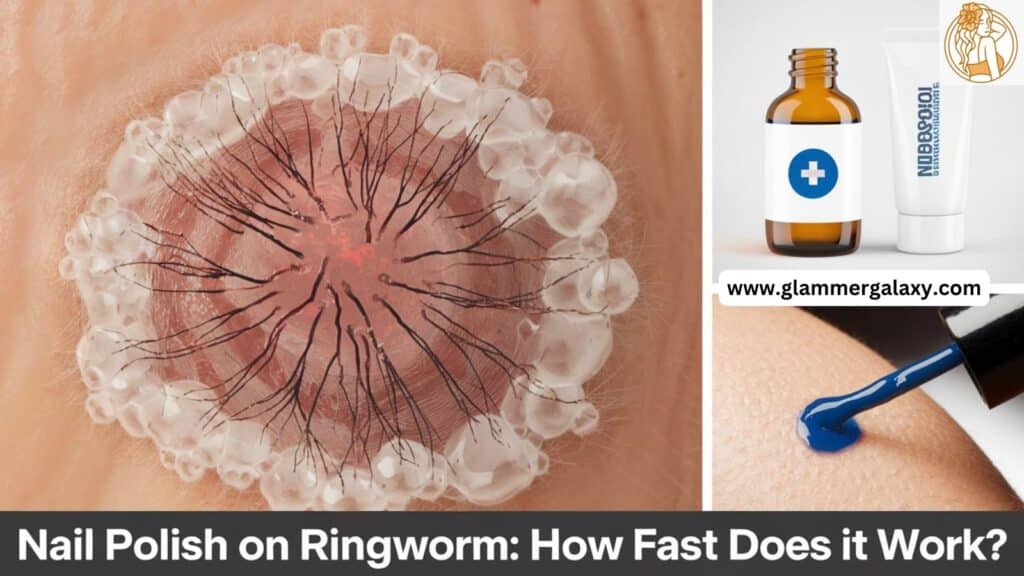In the world of skin health and nail fashion, an unusual remedy has caught the attention of many: using clear nail polish as a ringworm treatment.
This unorthodox approach has sparked curiosity and debate among those seeking alternatives to conventional medications. But does it really work? Let’s dive deep into the world of fungal infections and explore the potential of this surprising treatment method.
Understanding Ringworm: More Than Just a Pesky Skin Problem
Contrary to its name, ringworm isn’t caused by worms at all. It’s a fungal infection that affects the skin, scalp, or nails. The culprits behind this condition are dermatophytes, a group of fungi that thrive on the keratin found in our skin, hair, and nails.
Common Causes and Risk Factors
Ringworm loves warm, moist environments. Here’s what puts you at risk:
- Direct skin-to-skin contact with an infected person or animal
- Sharing personal items like towels or combs
- Walking barefoot in public showers or locker rooms
- Excessive sweating
- Weakened immune system
The fungi responsible for ringworm can survive on surfaces for months, making it easy to contract the infection from contaminated items or environments. Athletes, especially those involved in contact sports, are particularly susceptible due to frequent skin-to-skin contact and shared facilities.
Symptoms:
Ringworm typically appears as a red, scaly, itchy patch on the skin. As it grows, it often takes on a ring-like shape with a clearer center, hence the name. But don’t be fooled – it can manifest in various ways depending on the location:
| Body Part | Appearance |
| Skin | Circular, red, itchy patches |
| Scalp | Scaly, itchy patches with hair loss |
| Nails | Thickened, discolored, or brittle nails |
| Groin | Red, itchy rash (jock itch) |
| Feet | Scaling or cracking skin (athlete’s foot) |
It’s important to note that ringworm can spread quickly, both on your own body and to others. The itching associated with the infection can lead to scratching, which may cause the fungus to spread to other areas or create open wounds susceptible to secondary bacterial infections.
The Science Behind Nail Polish as a Ringworm Treatment
Now, let’s tackle the burning question: Can clear nail polish really treat ringworm? To understand this, we need to look at the components of nail polish and how they might interact with fungal infections.
How Nail Polish Might Work Against Fungal Infections
The theory behind using nail polish for ringworm treatment stems from its ability to create a barrier. When applied to the skin, nail polish forms a seal that might:
- Suffocate the fungus by cutting off its oxygen supply
- Prevent the fungus from spreading to other areas
- Lock in any antifungal components present in the polish
This barrier method is similar to some traditional treatments for minor skin conditions. For example, applying a layer of clear nail polish is a common home remedy for warts, based on the idea of suffocating the virus causing the wart.
Active Ingredients: The Potential Fungus Fighters
Some nail polishes contain ingredients that could potentially have antifungal properties:
- Formaldehyde: A preservative with antimicrobial effects
- Tosylamide/formaldehyde resin: Another potential antimicrobial agent
- Camphor: Known for its antifungal properties
- Ethyl acetate: A solvent that may have some antimicrobial activity
- Butyl acetate: Another solvent with potential antimicrobial effects
However, it’s crucial to note that these ingredients aren’t present in concentrations intended for medical use. Their primary purpose in nail polish is to create a durable, long-lasting finish on nails, not to treat skin conditions.
Limitations: Why It’s Not a Miracle Cure
While the idea seems promising, there are significant limitations:
- Nail polish isn’t designed for skin application
- The antifungal components aren’t in therapeutic doses
- It may irritate the skin or cause allergic reactions
- The barrier effect could trap moisture, potentially worsening the infection
- The effectiveness may vary greatly depending on the specific formulation of the nail polish
Moreover, the skin on most parts of the body is quite different from nail beds. What works for nails may not be suitable or effective for skin infections.
Effectiveness of Nail Polish on Ringworm: Anecdotes vs. Science
The internet is rife with stories of people claiming success with this unconventional treatment. But what does the scientific community say?
Anecdotal Evidence: The Power of Personal Stories
Many users report positive experiences, citing:
- Quick relief from itching
- Visible improvement in a few days
- Complete clearance of the infection in 1-2 weeks
“I was skeptical, but desperate. After three days of applying clear nail polish, my ringworm patch started to fade!” – Sarah, 28
These anecdotes often highlight the quick action and easy availability of nail polish as key advantages. Some users claim that the clear polish allowed them to monitor the infection’s progress easily.
Scientific Studies: The Missing Piece
Here’s where things get tricky. There’s a significant lack of scientific studies specifically examining the use of nail polish for ringworm treatment. Most dermatologists and medical professionals don’t recommend this method due to:
- Lack of clinical trials
- Potential risks of skin irritation
- Concerns about delaying proper treatment
- Absence of standardized application methods or dosages
The medical community generally advises against using products on the skin that aren’t specifically formulated for that purpose. The risks of adverse reactions or ineffective treatment often outweigh any potential benefits.
Factors Affecting Potential Effectiveness
If nail polish does work for some people, several factors might influence its effectiveness:
- Type of fungus: Some strains might be more susceptible than others
- Location of the infection: Skin folds or moist areas might respond differently
- Individual skin type: Sensitive skin may react poorly to nail polish
- Severity of the infection: Mild cases might respond better than severe ones
- Brand and composition of nail polish: Different formulations may have varying effects
- Consistency of application: How often and how carefully the polish is applied could impact results
- Overall health of the individual: A strong immune system may contribute to better outcomes
It’s worth noting that even if nail polish shows some effectiveness, it may not be addressing the root cause of the infection. Superficial treatment without eliminating the fungus completely could lead to recurrence.
You might like reading:
Step-by-Step Guide: Using Nail Polish on Ringworm
If you’re considering trying this method, it’s crucial to approach it carefully. Here’s a detailed guide:
Choosing the Right Nail Polish
Not all nail polishes are created equal. Here’s what to look for:
- Clear polish: It allows you to monitor the infection
- Acetone-free: Less drying and irritating to the skin
- Formaldehyde-free: If you have sensitive skin
- Non-toxic formulas: Look for brands that advertise as “3-free” or “5-free,” indicating they lack certain harsh chemicals
Avoid polishes with:
- Strong fragrances
- Glitter or other particles
- Dark colors that might stain the skin
- Quick-dry formulas, which often contain harsher chemicals
When selecting a nail polish, consider brands that market themselves as more natural or skin-friendly. While these aren’t guaranteed to be safe for skin application, they may be less likely to cause irritation.
Preparing the Affected Area
Before application:
- Wash the area gently with mild soap and water
- Pat dry thoroughly – fungi love moisture!
- If possible, allow the area to air out for a few minutes
- Ensure the area is free from other products or medications
- If you have hair in the area, consider trimming it for easier application
It’s crucial to start with a clean, dry surface to maximize the potential effectiveness of the nail polish and minimize the risk of trapping bacteria or other contaminants under the polish layer.
Proper Application Technique
Follow these steps for the best results:
- Use a clean, disposable applicator (not the brush from the bottle)
- Apply a thin, even layer over the affected area
- Extend slightly beyond the visible edge of the infection
- Allow to dry completely – this usually takes 10-15 minutes
- Apply a second thin layer for better coverage
- Let the second layer dry thoroughly before covering the area
When applying, be careful not to spread the polish too far beyond the infected area, as this could irritate healthy skin unnecessarily.
Post-Application Care
After applying the nail polish:
- Keep the area dry
- Avoid tight clothing or excessive sweating
- Monitor for any signs of irritation or worsening symptoms
- Don’t pick at or peel off the polish layer
- Continue normal hygiene practices, being careful not to scrub off the polish
If you need to bathe or shower, try to keep the polished area dry if possible. If it does get wet, gently pat it dry and consider reapplying a thin layer of polish.
Reapplication Guidelines
- Apply once daily for 3-7 days
- Remove old layers with non-acetone nail polish remover before reapplying
- If no improvement is seen after a week, discontinue use and seek medical advice
- Even if improvement is seen, don’t continue the treatment for more than two weeks without consulting a healthcare provider
Remember, consistent application is key if you’re trying this method. However, it’s equally important to know when to stop and seek professional help.
Potential Risks and Side Effects: Proceed with Caution
While some swear by this method, it’s not without risks:
- Skin irritation: Nail polish can be harsh on sensitive skin, potentially causing redness, itching, or burning sensations.
- Allergic reactions: Some ingredients in nail polish may trigger allergies, leading to more severe skin reactions.
- Masking symptoms: The polish might hide worsening infection, delaying proper treatment and potentially allowing the fungus to spread.
- Spreading the infection: Improper application could lead to contamination of other areas or tools used for application.
- Interaction with other treatments: May interfere with prescribed medications or make it difficult to apply other treatments.
- Skin damage: Repeated application and removal of nail polish can dry out the skin, potentially causing cracks or fissures that could lead to secondary infections.
- Systemic effects: While unlikely, there’s a small risk of the chemicals in nail polish being absorbed through the skin, especially if applied to large areas or used long-term.
“I tried nail polish on my ringworm, and it seemed to work at first. But after a few days, my skin became red and irritated. I ended up needing stronger medication from my doctor.” – Mike, 35
This case highlights the importance of monitoring your skin closely when trying any unconventional treatment. What seems like improvement initially may be a sign of irritation or an adverse reaction.
See also:
How to Fade Purple Hair to Silver
Precautions and Best Practices: Safety First
If you’re determined to try this method, follow these precautions:
- Consult a healthcare professional: Always get a proper diagnosis first. What you think is ringworm could be another skin condition that requires different treatment.
- Patch test: Apply a small amount to a healthy skin area to check for reactions. Wait 24 hours to ensure no adverse effects occur.
- Maintain hygiene: Keep the area and your hands clean to prevent spreading. Use separate towels and clothes for the affected area.
- Monitor closely: Watch for any signs of worsening or new symptoms. Take clear, well-lit photos daily to track any changes.
- Know when to stop: If symptoms persist or worsen, seek medical help immediately. Don’t continue the treatment for more than two weeks without professional advice.
- Avoid mixing treatments: Don’t combine nail polish with other over-the-counter or prescription treatments unless advised by a healthcare provider.
- Protect the treated area: Consider covering the polished area with a breathable bandage to prevent the polish from rubbing off on clothes or bedding.
- Inform others: If you live with family or roommates, let them know about your condition to prevent spread and ensure they don’t accidentally use any items that may be contaminated.
Remember, while home remedies can be tempting, they should never replace proper medical care, especially for persistent or severe infections.
Alternative Home Remedies: Other Options to Consider
While nail polish is an unconventional choice, there are other home remedies with more scientific backing:
Over-the-Counter Antifungal Treatments
These are specifically designed to treat fungal infections:
- Clotrimazole: Available as creams or powders, effective against many types of fungal infections.
- Miconazole: Often found in athlete’s foot treatments, also works on other fungal skin infections.
- Terbinafine: Effective against various types of fungi, available in cream or gel form.
- Tolnaftate: Commonly used for athlete’s foot, jock itch, and ringworm.
These products are formulated to penetrate the skin and target the fungus directly, making them more reliable than nail polish for treating ringworm.
Natural Remedies with Scientific Support
Some natural options have shown promise in studies:
- Tea tree oil: Has proven antifungal properties. Dilute with a carrier oil before applying to the skin.
- Garlic: Contains allicin, a compound with antifungal effects. Can be applied as a paste or taken orally.
- Apple cider vinegar: May help create an inhospitable environment for fungi. Apply diluted to the skin or use in a foot soak.
- Aloe vera: Has both antifungal and soothing properties, helping to reduce inflammation and itching.
- Coconut oil: Contains medium-chain fatty acids that have antifungal properties.
When using natural remedies, it’s important to remember that “natural” doesn’t always mean safe or effective for everyone. Always do a patch test and consult with a healthcare provider before starting any new treatment regimen.
Lifestyle Changes to Support Treatment
Complementing any treatment with these habits can speed up recovery:
- Keep affected areas clean and dry
- Wear breathable, loose-fitting clothing
- Change socks and underwear daily
- Avoid walking barefoot in public areas
- Use separate towels and washcloths for the infected area
- Wash bedding and clothes in hot water regularly
- Avoid scratching the affected area to prevent spreading
- Strengthen your immune system through diet, exercise, and stress management
These lifestyle changes not only help in treating current infections but also play a crucial role in preventing future occurrences of ringworm and other fungal infections.
Case Studies: Real-Life Experiences with Nail Polish Treatment
To provide a balanced view, let’s look at a few case studies of people who tried the nail polish method:
Case 1: Sarah’s Success Story Sarah, a 28-year-old office worker, noticed a small, itchy patch on her arm. After confirming it was ringworm, she decided to try clear nail polish. “I applied it twice daily for a week. By day 5, the itching had stopped, and the redness was fading. After two weeks, it was completely gone.”
Case 2: Tom’s Mixed Results Tom, a 35-year-old athlete, tried nail polish on a stubborn case of athlete’s foot. “It seemed to help with the itching at first, but after a few days, my skin became irritated. I switched to an over-the-counter antifungal cream, which worked much better.”
Case 3: Lisa’s Cautionary Tale Lisa, a 42-year-old teacher, used nail polish on what she thought was ringworm. “The polish seemed to make it better initially, but it turned out to be eczema. The delay in getting proper treatment made my condition worse. I learned the hard way to always get a proper diagnosis first.”
These cases highlight the varied experiences people have had with this unconventional treatment, underscoring the importance of careful consideration and professional advice.
The Role of Nail Polish in Skin Health and Fungal Infections
While not designed for skin treatment, nail polish has found its way into various beauty and health hacks. Let’s explore its properties and potential effects on skin:
Composition of Nail Polish
Typical ingredients in nail polish include:
- Film-forming agents (e.g., nitrocellulose)
- Plasticizers (e.g., camphor)
- Solvents (e.g., ethyl acetate, butyl acetate)
- Resins and polymers
- Colorants and pigments
- UV stabilizers
Some of these components, particularly solvents and plasticizers, may have mild antimicrobial properties, which could contribute to the perceived effectiveness against fungal infections.
Nail Polish and Skin Interaction
When applied to skin, nail polish creates a barrier that:
- Blocks air and moisture exchange
- May trap existing moisture or fungal spores
- Could potentially irritate or dry out the skin
This barrier effect is why some people find temporary relief from itching when using nail polish on fungal infections. However, it’s this same effect that can potentially worsen the infection by creating a favorable environment for fungal growth.
Potential Benefits vs. Risks
| Potential Benefits | Risks |
| Easy availability | Skin irritation |
| Quick application | Allergic reactions |
| Temporary itch relief | Masking symptoms |
| Possible antifungal effects | Delaying proper treatment |
| Clear formula allows monitoring | Potential spreading of infection |
You may also like this article : Can I Use Eyeliner On My Lips?
The Importance of Professional Diagnosis and Treatment
While home remedies like nail polish may seem appealing, it’s crucial to emphasize the importance of professional medical advice when dealing with skin infections. Here’s why:
- Accurate Diagnosis: Many skin conditions can mimic ringworm. A healthcare provider can accurately diagnose the problem.
- Appropriate Treatment: Doctors can prescribe targeted treatments that are proven effective against fungal infections.
- Preventing Complications: Untreated or improperly treated ringworm can spread or lead to secondary infections.
- Identifying Underlying Issues: Recurring fungal infections may indicate other health problems that need addressing.
- Safety: Professional treatments have undergone rigorous testing for safety and efficacy, unlike home remedies.
Remember, while exploring alternative treatments can be interesting, your health should always be the top priority.
Conclusion: Weighing the Pros and Cons
The use of clear nail polish as a ringworm treatment remains a controversial topic. While some swear by its effectiveness, the lack of scientific evidence and potential risks make it a questionable choice.
Key takeaways:
- Nail polish isn’t designed or approved for treating skin infections
- Some users report success, but experiences vary widely
- Potential risks include skin irritation and delayed proper treatment
- Over-the-counter antifungal treatments are safer and more reliable options
Ultimately, your skin health is too important to gamble with. If you’re dealing with a suspected ringworm infection, the wisest course of action is to consult a healthcare professional. They can provide a proper diagnosis and recommend safe, effective treatments tailored to your specific case.

Sarah Williams is an experienced blogger and fashion enthusiast at Glammer Galaxy. With a passion for beauty and style, she shares expert insights on hair trends, nail art, and fashion tips. Her creative flair and years of experience make her a go-to source for all things glam!







